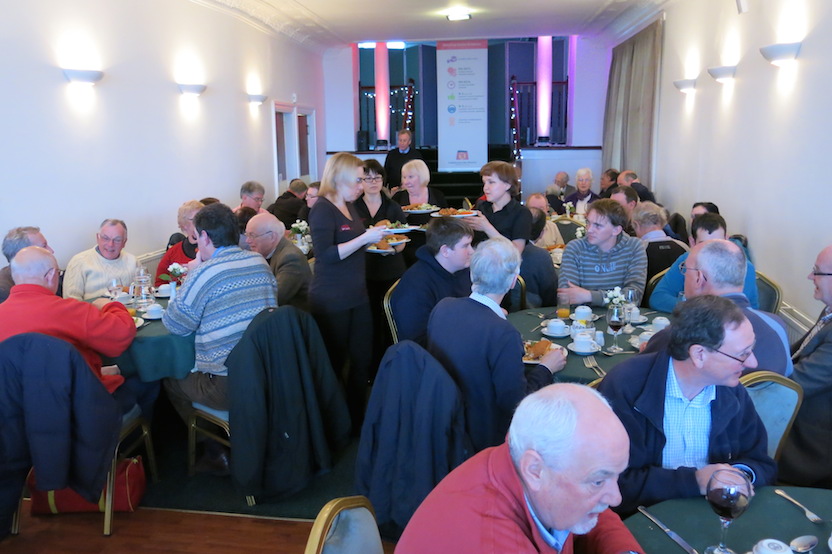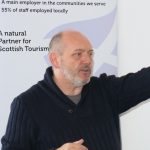 It was a stunning admission: “I struggle with not being able to procure my own vessels.” CalMac managing director Martin Dorchester was speaking to CRSC members and friends in Rothesay’s Victoria Hotel, where more than 60 enjoyed an excellent lunch on Saturday 9 January 2016, before boarding the car ferry Argyle for the return voyage to Gourock.
It was a stunning admission: “I struggle with not being able to procure my own vessels.” CalMac managing director Martin Dorchester was speaking to CRSC members and friends in Rothesay’s Victoria Hotel, where more than 60 enjoyed an excellent lunch on Saturday 9 January 2016, before boarding the car ferry Argyle for the return voyage to Gourock.
Mr Dorchester’s participation, along with eight other senior CalMac representatives, was the standout feature of the Club’s excursion to Rothesay, marking the first time the ferry company has engaged in this level of dialogue with a group of ship enthusiasts.
In his virtuoso PowerPoint address, full of candour, realism and self-deprecating humour, Mr Dorchester took us on a tour of CalMac’s many challenges and prospects. The recurring theme was his frustration at having to work within a legal framework that gave him short-term operational responsibility for the network of ferries and harbours on the west of Scotland, but denied him power over procurement — a role devolved since 2006 to Port Glasgow-based Caledonian Maritime Assets Ltd (CMAL), which owns the ports and decides what kind of ferries should be built.
 “Vessel size and port size — these are the long-term things we should be discussing,” he said. While avoiding direct criticism of CMAL or the Scottish government, he asked: “What happens 10 or 20 years down the line? We’re realising it’s better to fix your infrastructure before you start planning your boat [the implication being that this is not happening at present]. But it’s hard to get the right vessels if you’re not [the organisation] procuring them.”
“Vessel size and port size — these are the long-term things we should be discussing,” he said. While avoiding direct criticism of CMAL or the Scottish government, he asked: “What happens 10 or 20 years down the line? We’re realising it’s better to fix your infrastructure before you start planning your boat [the implication being that this is not happening at present]. But it’s hard to get the right vessels if you’re not [the organisation] procuring them.”
The talk underlined Mr Dorchester’s transport service background, where the imperative is to maximise revenue. Wryly noting that “when I ran a distribution company, I chose my own trucks”, he said that on a recent visit to the Estonian capital, Tallinn, he had been impressed by the size and ambition of infrastructure projects there, all of which posed the question: “What do you want these ports [in the west of Scotland] to look like in 30 years’ time? It’s hard to get politicians to think that far ahead. But if the aim of government is to grow your population [in the Hebrides], you’re not going to do it overnight. It’s a long-term play.”
As for the new competitive tender to run Clyde and Hebridean ferry services, the winner of which is to be announced at the end of May 2016, Mr Dorchester said the unexpectedly elongated bidding process had been tough, distracting CalMac Ferries Ltd from its task of running a service. “No one realised in 2007, when the CalMac business was first put out to tender, the huge change involved in running a business on contract, as opposed to a public service monopoly [which it had been previously]. My team have gone through a bid process over a long period, and that’s quite hard to live with when you don’t know what’s going to happen. You’re bidding for a living, for your future.”
 Following two recent preliminary deadlines (September 21 and January 5), the Scottish government will issue a formal ‘Invitation to submit a final tender’ on February 15, to which CalMac and other interested parties will have to respond with a final tender, including costs, by March 7. On May 31, three weeks after the Scottish elections, the government will announce an ‘Intent to award contract’ to its preferred bidder. The proposed start-date for the CHFS2 public service contract follows just four months later, on October 1.
Following two recent preliminary deadlines (September 21 and January 5), the Scottish government will issue a formal ‘Invitation to submit a final tender’ on February 15, to which CalMac and other interested parties will have to respond with a final tender, including costs, by March 7. On May 31, three weeks after the Scottish elections, the government will announce an ‘Intent to award contract’ to its preferred bidder. The proposed start-date for the CHFS2 public service contract follows just four months later, on October 1.
Mr Dorchester said CalMac’s growing emphasis on community engagement and “connectivity” — the linkage between sea services, internet services and wider transport networks — made it well-placed to win the contract. “Communities are not shy of telling me whenever we get it wrong. It keeps our feet on the ground. That doesn’t mean we always say ‘yes’. If we allow our communities to determine our future, we won’t have a business [in areas with a tradition of declining population]. Our boats go two ways. If we want to maintain existing routes, we need to be cleverer [about ways to grow the business].”
Mr Dorchester had begun his presentation with facts and figures. CalMac operates 32 ferries on 49 routes. It employs 1,476 people (281 in Argyll & Bute alone) and has a turnover of £169m. It carries 4.65m passengers and 1.1m cars annually, as well as 93,000 commercial vehicles and 11,000 coaches. Any income over £1.8m is returned to the Scottish government.
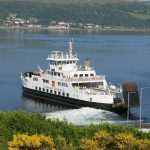 He noted that, for most people, CalMac was synonymous with the Western Isles, where many of the bigger ferries operated. “But the million-volume routes are all on the Clyde. Around 3m of Scotland’s 5m population are here in the central belt.”
He noted that, for most people, CalMac was synonymous with the Western Isles, where many of the bigger ferries operated. “But the million-volume routes are all on the Clyde. Around 3m of Scotland’s 5m population are here in the central belt.”
Responding to questions about Road Equivalent Tariff (RET), Mr Dorchester said it would “hit us” by changing travel patterns, “and we’ll have to work our way round that. If we have a good summer with RET, especially on the Clyde, the numbers could go astronomical. We won’t know the impact until the contract has been won. We’ll have to see whether the rise in usage offsets the loss of revenue [caused by lower fares]. Then we’ll sit down with government and discuss it.”
But “at macro level the squeeze is coming” — an acknowledgement that CalMac, like the island communities it serves, cannot rely on ever-increasing subsidy from the taxpayer. The deciding factors in future would be economic viability and sustainability. He wanted more investment in roads to and from highland ports, and in roads on Mull, where a substantial part of the Craignure-Tobermory link is still single-track. The problem of ship overcapacity in winter and undercapacity in summer would also have to be addressed. “How do we look at that and defray [the costs of] that?”
 Asked why CalMac had bid for (and won) the contract to operate Ministry of Defence port facilities at Marchwood on the western side of Southampton Water, and whether this would be a distraction from its ‘lifeline’ business in Scotland, he said that “when tendering [for a contract such as the Clyde and Hebridean business], you’ll be scored on the bidding contracts you have. You’ve got to be good at bidding. I think we’ll make a lot of money from Marchwood. We can learn from it, invest in it, and bring money back to Scotland.”
Asked why CalMac had bid for (and won) the contract to operate Ministry of Defence port facilities at Marchwood on the western side of Southampton Water, and whether this would be a distraction from its ‘lifeline’ business in Scotland, he said that “when tendering [for a contract such as the Clyde and Hebridean business], you’ll be scored on the bidding contracts you have. You’ve got to be good at bidding. I think we’ll make a lot of money from Marchwood. We can learn from it, invest in it, and bring money back to Scotland.”
The talk was chaired by CRSC president Angus Ross, who described the gathering as a captive audience, given that the CRSC was CalMac’s biggest and most knowledgeable fan club.
A hearty vote of thanks was accorded not only to Mr Dorchester, but also to the staff of the Victoria Hotel for their excellent service, and to Neil Guthrie, CRSC cruise coordinator, for his organisation of this exceptional event.
Despite poor weather conditions, there was a notably convivial atmosphere on board Argyle on the return journey to Gourock. By general consent, the trip to Rothesay in company with Mr Dorchester and his colleagues had been a good PR exercise for CalMac. Whether it will lead to closer and more regular contact with the Club remains to be seen.

CRSC president Angus Ross (left) and cruise coordinator Neil Guthrie (right), with CalMac non-executive director Jim Stirling and managing director Martin Dorchester – CRSC copyright photo

Angus Ross (right) introduces Martin Dorchester (left) to the gathering of CRSC members and friends – CRSC copyright photo

CalMac operations director Drew Collier (left) with fleet administrator Stewart Mungin – CRSC copyright photo

Martin Dorchester (left) chats to CRSC member Lawrence Macduff after Mr Dorchester’s address – CRSC copyright photo
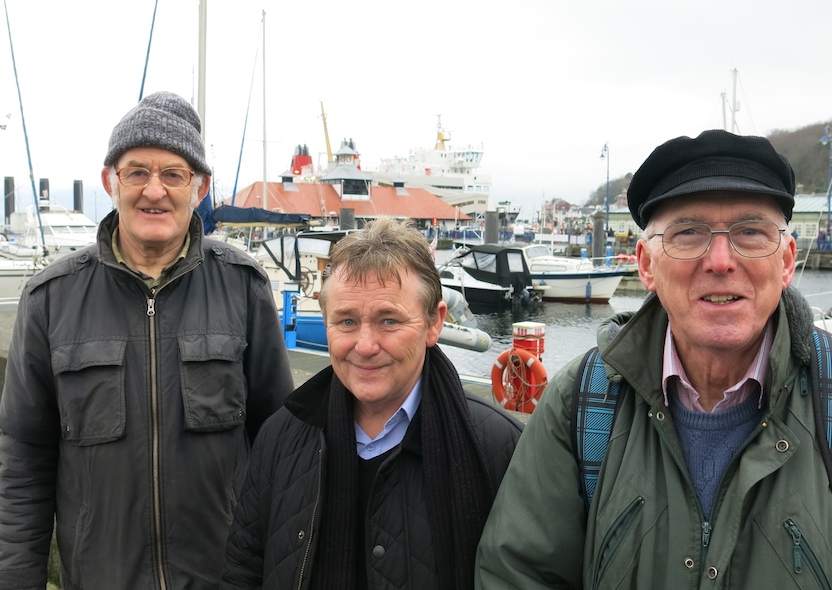
Calum Bryce (centre), off-duty master of car ferry Bute, flanked by Lawrence Macduff and Craig Osborne – CRSC copyright photo
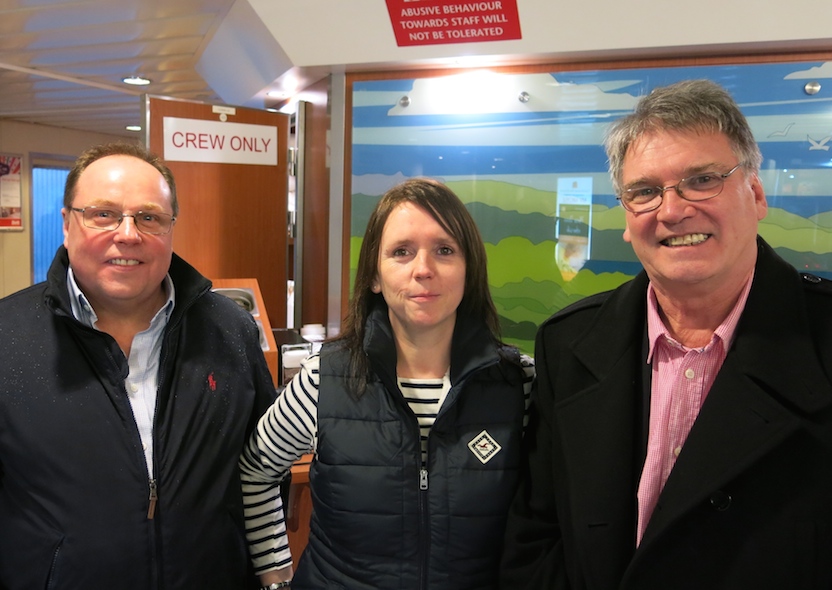
Robert Kelso, CalMac’s fleet technical manager (left), with onboard development manager Anne Mitchell and Eric Smith, general manager, operations – CRSC copyright photo
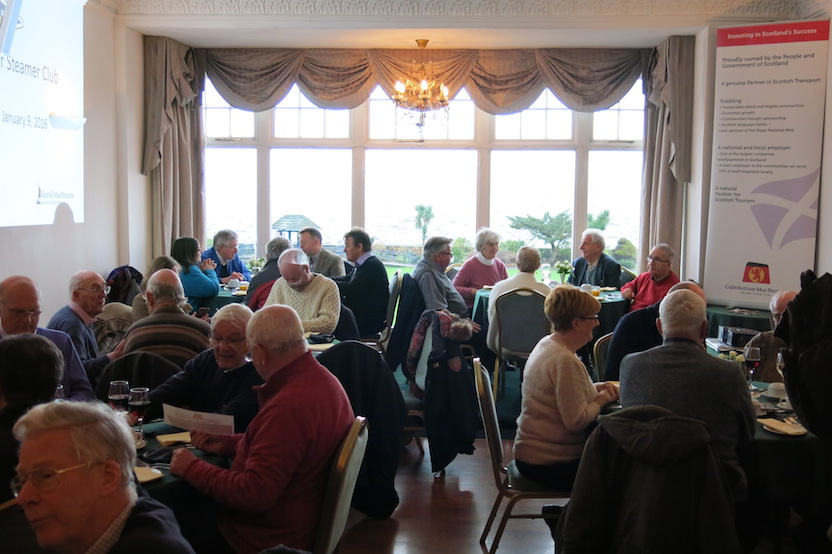
More than 60 CRSC members and friends enjoyed an excellent lunch at Rothesay’s Victoria Hotel – CRSC copyright photo
Published on 10 January 2016












